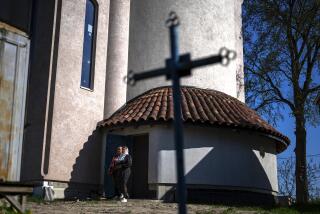Leafy Emblem of Ukraine Withering Away
ZAPORIZHIA, Ukraine — One of the oldest and largest living things in the land, it was probably an acorn when Genghis Khan’s descendants sacked Kiev, the Ukrainian capital, in the 13th century. Four hundred years later, Cossacks gathered under its boughs before battle.
But after 700 years on Earth, the mighty Zaporizhian Oak is dying.
“It’s not completely dead yet,” says grizzled Cossack watchman Boris Stupachenko, pointing to the sole living branch near the top of the 120-foot-tall tree. “That limb can survive for about two more years.”
The rest of the magnificent 140-foot-wide crown is bare, in surreal contrast to the verdant suburb surrounding it.
“Why did the oak die?” 9-year-old Ihor Savchyk asks a visitor as he watches over a goat grazing in its sparse shade.
The answer depends on whom you ask.
Officially, the main cause of death is old age. “It had lived out its life,” says Natalia Dubil, an environmental official of this smokestack city in southern Ukraine.
Others say neglect of the tree in the 1980s led it to drown in rising ground water.
Oaks can live beyond a millennium. A Baltic specimen is 2,000 years old. Other factors entered into the oak’s decline.
Although the oldest oak on the Ukrainian steppes was a protected natural monument, conservation was a low priority in Soviet times, and environmentalists were practically political dissidents.
So were people like Nechipur Deikun, the tree’s guardian after World War II. He was, by all accounts, a conscientious caretaker. When ground-water levels started rising in the late 1950s, Deikun got the tree a drainage system.
He also got in trouble.
“He would sing old Cossack songs and ballads, tell visitors stories about the Zaporizhian Cossacks,” Stupachenko recalls.
Zaporizhia means “beyond the rapids,” the treacherous white waters that made the 50-mile stretch of Dnepr River to the north nonnavigable during certain seasons.
And it was here, centuries ago, that the Ukrainian Cossacks built their armed camp, beyond the rapids and the reach of Polish kings and Russian czars. Few subjects resonate as deeply in Ukrainian history, and talking about it in Soviet times was a risky activity. In 1960, Deikun was forced to abandon the oak and move where his audience would be smaller. He died a year later.
Soon afterward, the suburb surrounding the tree expanded with neat cottages and vegetable gardens. A paved pavilion was built under the oak so tourists could stroll beneath its leafy boughs.
In 1965, Hryhory Rybka was one of them, and he has visited the tree every month since. “This oak symbolized the Cossacks, and it was special because it lasted,” he says, waving his cigarette at the gnarled, ancient trunk.
Survival was no small feat. Trees were rare on the steppes except in ravines and fertile river valleys. But those forests were largely razed for lumber after Russia’s annexation of the Crimea and its destruction of the Zaporizhian Cossacks in 1775.
Deforestation throughout Ukraine picked up pace in the 19th century and reached crisis proportions during Soviet times.
No one knows why the Zaporizhian Oak escaped the lumber mills. It had no state protection until 1958. But the last survivor of the primordial Dnepr valley forests came to symbolize all the oaks in Cossack legends.
“So many Cossack events took place near oaks, there’s no way of knowing which oak precisely,” says Cossack expert Georgi Kropyvka. “But the Zaporizhian Oak was a witness to history.”
About 10 years ago, Rybka noticed that the tree’s top branches were starting to dry out. That should have sounded alarms but didn’t until 1991, when the oak’s stunted leaves signaled its illness.
“It was drowning,” Stupachenko says.
Accustomed to the light rainfall of the steppes, the oak’s 300-foot-wide root network reached deep into the ground for moisture, and that was too deep when the ground water rose as development in the area expanded.
Critics say the drainage system would have saved the tree had it not been clogged after years of neglect. Indeed, in 1992 the ground water dropped--but it was too late. After dendrologists diagnosed the tree’s condition as fatal, Zaporizhia’s latter-day Cossacks set up a 24-hour watch against mischief makers, like one group of toughs who thought the dried-up oak would make a fine bonfire.
For centuries, one of the most enduring expressions of Ukrainian folk culture was a painting depicting a cross-legged Cossack resting under an oak tree. Most experts think the image reflected a collective memory of the Cossacks after Ukraine was absorbed into the Russian empire.
Today, Boris Stupachenko also rests under an oak, patting the dying patriarch’s 21-foot girth. But in an independent Ukraine, he thinks about the future, not the past.
More to Read
Sign up for Essential California
The most important California stories and recommendations in your inbox every morning.
You may occasionally receive promotional content from the Los Angeles Times.










